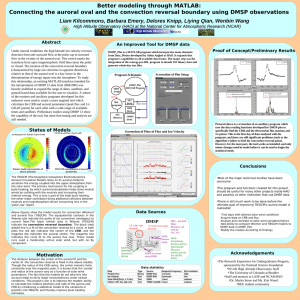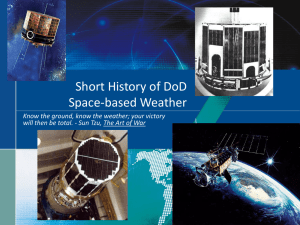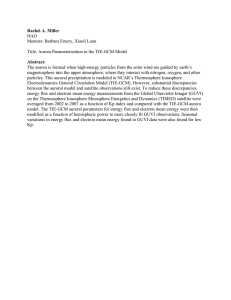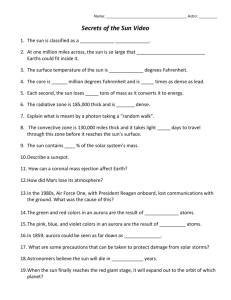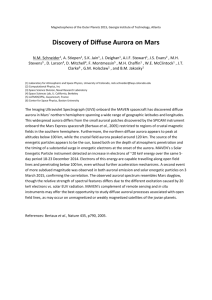Better modeling through MATLAB: Liam Kilcommons Mentors:
advertisement
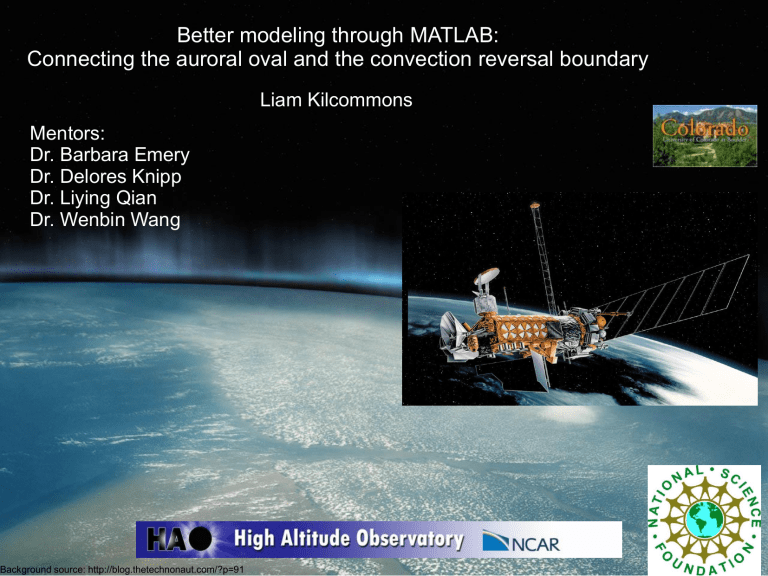
Better modeling through MATLAB: Connecting the auroral oval and the convection reversal boundary Liam Kilcommons Mentors: Dr. Barbara Emery Dr. Delores Knipp Dr. Liying Qian Dr. Wenbin Wang Background source: http://blog.thetechnonaut.com/?p=91 Motive, Means, and Opportunity Granted, the aurora is beautiful, but why bother studying it? You can't really get to the aurora, so where do you get your data? Actually, it's pretty important: In general: Auroral particle precipitation associated with Joule heating, biggest energy input (besides solar radiation) into upper atmosphere Ionospheric disturbances and accompanying electric and magnetic fields cause: Power grid damage GPS inaccuracy Air travel re-route Pigeon loss ground based remote sensing direct satellite measurements The aurora is pretty well studied, what else is there to know? Lots! Need better representation of atmosphere response to solar storms Models' representation of aurora needs to be improved (2nd biggest energy input!) Defense Meteorology Satellite Program satellites – aurora data In this case: OMNI – satellite solar wind and ground based data from various sources What's this Joule thing? Most familiar incarnation: Wires getting hotter due to current flow (a.k.a ohmic heating) Qj µ vi * Flux In upper atmosphere: 2 Neutral atoms getting hotter due to collisions with energetic electrons and ions e ve ion Drives 'neutral winds' vi Neutrals Momentum transfer Strong solar storms (lots of precipitation and fast ion convection) cause worldwide changes in neutral winds Auroral precipitation: e- and p+ Ion convection: ions of O, O2, N2 etc vp p Duskward, anti-sunward, and other mysterious directional adjectives Graphing as if one were looking down on the magnetic north pole Dawn 6 Noon 12 N Pole (90º) 0/24 70º Midnight 80º Not to scale http://www.atigun.com/photography/aurora-photographs/47-aurora-photographs 18 Dusk Angular coordinate = magnetic local time (MLT) Radial coordinate = magnetic latitude (MLAT) Ion Convection (or ion drift; the physics are the same) 6 View from the top N The Earth E 12 B 0/24 S Dawn-Dusk E-field! 18 Looks familiar... 6 6 DMSP Satellite in a dawn-dusk orbit 12 E x B gives direction of vi 18 Vi? The Ion Drift Velocity 0/24 12 0/24 vi 18 Convection Reversal Boundary (CRB) Our Data Sources: DMSP Satellites +X indicates Along-Track Direction Y indicates Cross-Track Direction -Z is Earthward Direction SSJ4 – Electron Flux IDM – Ion Drift Meter The beginning of this presentation, finally 6 The (scientific) problem: TIE-GCM needs to calculate Joule heating Joule heating calculation requires relative locations (difference in radii) of CRB and auroral 12 oval N.P. Positions change constantly and drastically with changes in solar wind TIE-GCM uses a constant (CRB 2 degrees duskward of auroral max flux) My goal: Gather statistics on real life relative CRB and aurora positions Revise a MATLAB data display program to display the CRB and aurora positions for a particular pass of a particular DMSP satellite on a particular day. 18 0/24 How I Spent My Summer Vacation The (Programming) Problem: Need a flexible graphical display environment to visualize many kinds of data with different formats Why? 'Big picture' view of sun interacting with high latitude upper atmosphere The Specifics: Incorporate solar data, auroral flux, and ion drift velocities Visualize many different variables, whatever user wants Data Name Data Source Date Range (DMSP F-13) (on site) Frequency of Measurements Format Headache Rating Particle Flux DMSP SSJ4 1987-2005 Every second Binary High Ion Drift Velocity DMSP IDM 1987-2002 Every 4 seconds ASCII Text Low OMNI Solar Various: Wind Composite ACE, Ground Based, etc. 1978 to Present Every Hour ASCII Text Low No Need to Reinvent the Wheel, Just Figure Out How It Rolls The foundation for our visualization tool was Data_Plotter: Matlab GUI ~ 6000 lines of code Originally designed to study neutral density response for specific solar events Feature Original Program: Data Plotter Desired Features for New Program Input Data Type Heavily Preprocessed Raw Satellite Data Available Times Only Selected Events, 2004,2005 Any date for which data for desired plots exists Available Datasets DMSP PF, IDM, SSJ CHAMP Neutral Density DMSP IDM, SSJ OMNI Solar Data Types of Plots Polar, Cartesian Polar, Cartesian Calculations None Convection Reversal Boundary, Auroral Max Flux Points No Need to Reinvent the Wheel, Just Figure Out How It Rolls The foundation for our visualization tool was Data_Plotter: Matlab GUI ~ 6000 lines of code Originally designed to study neutral density response for specific solar events Biggest Challenge Feature Original Program: Data Plotter Desired Features for New Program Input Data Type Heavily Preprocessed Raw Satellite Data Available Times Only Selected Events, 2004,2005 Any date for which data for desired plots exists Available Datasets DMSP PF, IDM, SSJ CHAMP Neutral Density DMSP IDM, SSJ OMNI Solar Data Types of Plots Polar, Cartesian Polar, Cartesian Calculations None Convection Reversal Boundary, Auroral Max Flux Points My Solution: DMSP_Plot.m CRB CRB Max Flux Max Flux ....and then, last night, around 11 pm there were: (Preliminary) Results! Max Flux CRB CRB Max Flux Progress Report Feature Original Program: Data Plotter Desired Features for New Goal Met? Program Input Data Type Heavily Preprocessed Raw Satellite Data Available Times Only Selected Events, 2004,2005 Any date for which data for Yes desired plots exists Available Datasets DMSP PF, IDM, SSJ CHAMP Neutral Density DMSP IDM, SSJ OMNI Solar Data Yes Types of Plots Polar, Cartesian Polar, Cartesian Partially; Yes Code still a little buggy Calculations None Convection Reversal Boundary, Auroral Max Flux Points Partially; Partial functionality in seperate code Future Work Perfect CRB and auroral maximum-flux-point finding algorithms Gather statistics on position of aurora center and CRB center and their relative radii as a function of solar wind parameters Compare results to modeled results Use results to devise empirical model for estimating center position and radii of auroral oval with respect to CRB Integrate model into TIEGCM for better Joule heating calculation THANK YOU! QUESTIONS?
